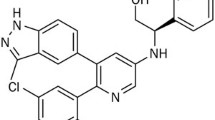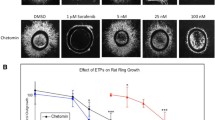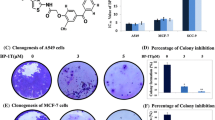Summary
Dysregulation of angiogenesis has been associated with many pathological disorders, including cancer; where angiogenesis has been found to be critical for the maintenance and metastasis of tumours. One of the pathways involved in the regulation of angiogenesis is the phosphatidylinositol3-kinase (PI3K) signalling pathway. The PI3K family consists of enzymes that phosphorylate the 3-OH of the inositol ring of phosphatidyl inositol. There are four isoforms, PI3Kα, PI3Kβ, PI3Kγ and PI3Kδ, that are signalling intermediaries involved in numerous pathways that sustain and maintain the tumours. In this study, we screened eight novel benzoxazine inhibitors of both PI3K isoforms and the related DNA-PK, for their anti-angiogenic effects. Our findings identified the novel benzoxazine (7, 8 (substituted)-2-morpholino-benz (1,3) oxazine: LTUSI122) to be non-toxic at concentrations up to 5 μM, while exhibiting significant inhibition of various aspects of angiogenesis including endothelial proliferation, migration and tube formation. The molecular mechanisms were examined using an angiogenesis array, revealing inhibition of several proliferative and migratory angiogenic factors, including VEGFR, MMP, IL-8, uPAR and MCP; and stimulation of the endogenous inhibitor, endostatin. We hypothesize that these anti-angiogenic effects are mediated by targeting an important signaling intermediary, PI3Kα, and subsequently its action on vascular endothelial growth factor (VEGF, a key growth factor in the process of angiogenesis). If used in combination with more targeted therapies, LTUSI122 could reduce tumour growth and increase the efficacy of these treatments.




Similar content being viewed by others
References
Brooks SA, Lomax-Browne HJ, Carter TM, Kinch CE, Hall DM (2010) Molecular interactions in cancer cell metastasis. Acta Histochem 112(1):3–25
Semenza GL (2012) Hypoxia-inducible factors: mediators of cancer progression and targets for cancer therapy. Trends Pharmacol Sci 33(4):207–14
Krock BL, Skuli N, Simon MC (2011) Hypoxia-induced angiogenesis: good and evil. Genes Cancer 2(12):1117–33
Chen HH, Zhou HJ, Fang X (2003) Inhibition of human cancer cell line growth and human umbilical vein endothelial cell angiogenesis by artemisinin derivatives in vitro. Pharmacol Res: Off J Ital Pharmacol Soc 48(3):231–6
Sieczkiewicz GJ, Hussain M, Kohn EC (2002) Angiogenesis and metastasis. Cancer Treat Res 107:353–81
Shih T, Lindley C (2006) Bevacizumab: an angiogenesis inhibitor for the treatment of solid malignancies. Clin Ther 28(11):1779–802
Roskoski R Jr (2007) Sunitinib: a VEGF and PDGF receptor protein kinase and angiogenesis inhibitor. Biochem Biophys Res Commun 356(2):323–8
Hyunseung L, Kyung J, Yujeong J, Sungwoo H, Soon-Sun H (2013) HS-173, a novel phosphatidylinositol 3-kinase (PI3K) inhibitor, has anti-tumor activity through promoting apoptosis and inhibiting angiogenesis. Cancer Lett 328(1):152–9
Graupera M, Guillermet-Guibert J, Foukas LC, Phng L-K, Cain RJ, Salpekar A et al (2008) Angiogenesis selectively requires the p110α isoform of PI3K to control endothelial cell migration. Nature 453(7195):662–6
Engelman JA, Luo J, Cantley LC (2006) The evolution of phosphatidylinositol 3-kinases as regulators of growth and metabolism. Nat Rev Genet 7:606–619
Cook KM, Figg WD (2010) Angiogenesis inhibitors: current strategies and future prospects. CA Cancer J Clin 60(4):222–43
Karar J, Maity A (2011) PI3K/AKT/mTOR pathway in angiogenesis. Front Mol Neurosci 4:51
Fitzgibbon C, Ihmaid S, Al-Rawi J, Meehan-Andrews T, Bradley C (2013) Chemo-sensitisation of HeLa cells to etoposide by a benzoxazine in the absence of DNA-PK inhibition. Investig New Drugs 31(6):1466–75
Abcam. Human Angiogenesis Antibody Array-Membrane (23 Target) 2014 Available from: http://www.abcam.com/human-angiogenesis-antibody-array-membrane-23-targets-ab169808.html
Abcam. Human Angiogenesis Antibody Array - Membrane (20 Targets) 2014 Available from: http://www.abcam.com/human-angiogenesis-antibody-array-membrane-20-targets-ab134000.html
Folkman J (2007) Angiogenesis: an organising principle for drug discovery? Nat Rev Drug Discov 6:273–286
Samant RS, Shevde LA (2011) Recent advances in anti-angiogenic therapy of cancer. Oncotarget 2(3):122–134
Xue Y, Li N-L, Yang J-Y, Chen Y, Yang L-L, Liu W-C (2011) Phosphatidylinositol 3′-kinase signaling pathway is essential for Rac1-induced hypoxia-inducible factor-1α and vascular endothelial growth factor expression. Am J Physiol Heart Circ Physiol 300(6):H2169–H76
Nutley BP, Smith NF, Hayes A, Kelland LR, Brunton L, Golding BT et al (2005) Preclinical pharmacokinetics and metabolism of a novel prototype DNA-PK inhibitor NU7026. Br J Cancer 93(9):1011–8
Ihmaid SK, Al-Rawi JMA, Bradley CJ, Angove MJ, Robertson MN (2012) Synthesis, DNA-PK inhibition, anti-platelet activity studies of 2-(N-substituted-3-aminopyridine)-substituted-1,3-benzoxazines and DNA-PK and PI3K inhibition, homology modelling studies of 2-morpholino-(7,8-di and 8-substituted)-1,3-benzoxazines. Eur J Med Chem 57:85–101
Dong Z, Cheng Y, Zhao J, Su L, Zhao B, Zhang Y et al (2010) Discovery of a benzoxazine derivative promoting angiogenesis in vitro and in vivo. J Cell Physiol 223(1):202–8
Mannell H, Hammitzsch A, Mettler R, Pohl U, Krotz F (2010) Suppression of DNA-PKcs enhances FGF-2 dependent human endothelial cell proliferation via negative regulation of Akt. Cell Signal 22(1):88–96
Morrison R, Belz T, Ihmaid S, Al-Rawi JA, Angove M (2014) Dual and/or selective DNA-PK, PI3K inhibition and isoform selectivity of some new and known 2-amino-substituted-1,3-benzoxazines and substituted-1,3-naphthoxazines. Med Chem Res 24:1–12
Conflict of interests
The authors declare that they have no conflict of interest.
Author information
Authors and Affiliations
Corresponding author
Rights and permissions
About this article
Cite this article
Al-Rawi, S., Meehan-Andrews, T., Bradley, C. et al. Novel benzoxazines as inhibitors of angiogenesis. Invest New Drugs 33, 45–52 (2015). https://doi.org/10.1007/s10637-014-0172-8
Received:
Accepted:
Published:
Issue Date:
DOI: https://doi.org/10.1007/s10637-014-0172-8




